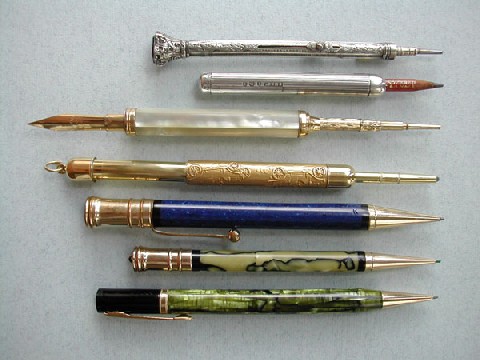 Graphite is a form of Carbon soft enough to leave a mark on a surface. A deposit of this mineral was discovered in England in 1564. Soon after this, sticks of this material were being used to write. The sticks were wrapped in strings avoiding the staining of the hands. With time, the graphite was inserted into wood sticks previously hollowed. By 1662 a mass production of wood pencils appeared in Germany. In 1794 the French chemist Nicolas Conte developed a process in which he fired a mixture of graphite and clay as ceramic sticks and put them into wood sticks. In this way the cutting was avoided and losses of material reduced. Besides, varying the proportion between the components the hardness of the final product could be modified, which was so important for artistic uses. In 1812 was discovered that by application of pressure the addition of clay was unnecessary. All the early pencils were made of wood or metallic sticks that kept the graphite in place by pressure. But appeared the idea to produce pencils in which the graphite stick could be pushed out of the holder and mechanical pencils made their appearance. Even though Sampson Mordan was not the first in producing these pencils he obtained a patent in England in 1822 and his name is associated to the invention of these pencils. Many of the early mechanical pencils uses different mechanisms and are a permanent exhibition of imagination and creativity. As fountain pens become more and more popular, the companies that produce them incorporate the pencils in matching line with the pens and the enormous multiplicity of designs was reduced. For this reason the collection of these early mechanical pencils is so appealing and rewarding. Graphite is a form of Carbon soft enough to leave a mark on a surface. A deposit of this mineral was discovered in England in 1564. Soon after this, sticks of this material were being used to write. The sticks were wrapped in strings avoiding the staining of the hands. With time, the graphite was inserted into wood sticks previously hollowed. By 1662 a mass production of wood pencils appeared in Germany. In 1794 the French chemist Nicolas Conte developed a process in which he fired a mixture of graphite and clay as ceramic sticks and put them into wood sticks. In this way the cutting was avoided and losses of material reduced. Besides, varying the proportion between the components the hardness of the final product could be modified, which was so important for artistic uses. In 1812 was discovered that by application of pressure the addition of clay was unnecessary. All the early pencils were made of wood or metallic sticks that kept the graphite in place by pressure. But appeared the idea to produce pencils in which the graphite stick could be pushed out of the holder and mechanical pencils made their appearance. Even though Sampson Mordan was not the first in producing these pencils he obtained a patent in England in 1822 and his name is associated to the invention of these pencils. Many of the early mechanical pencils uses different mechanisms and are a permanent exhibition of imagination and creativity. As fountain pens become more and more popular, the companies that produce them incorporate the pencils in matching line with the pens and the enormous multiplicity of designs was reduced. For this reason the collection of these early mechanical pencils is so appealing and rewarding.
|

